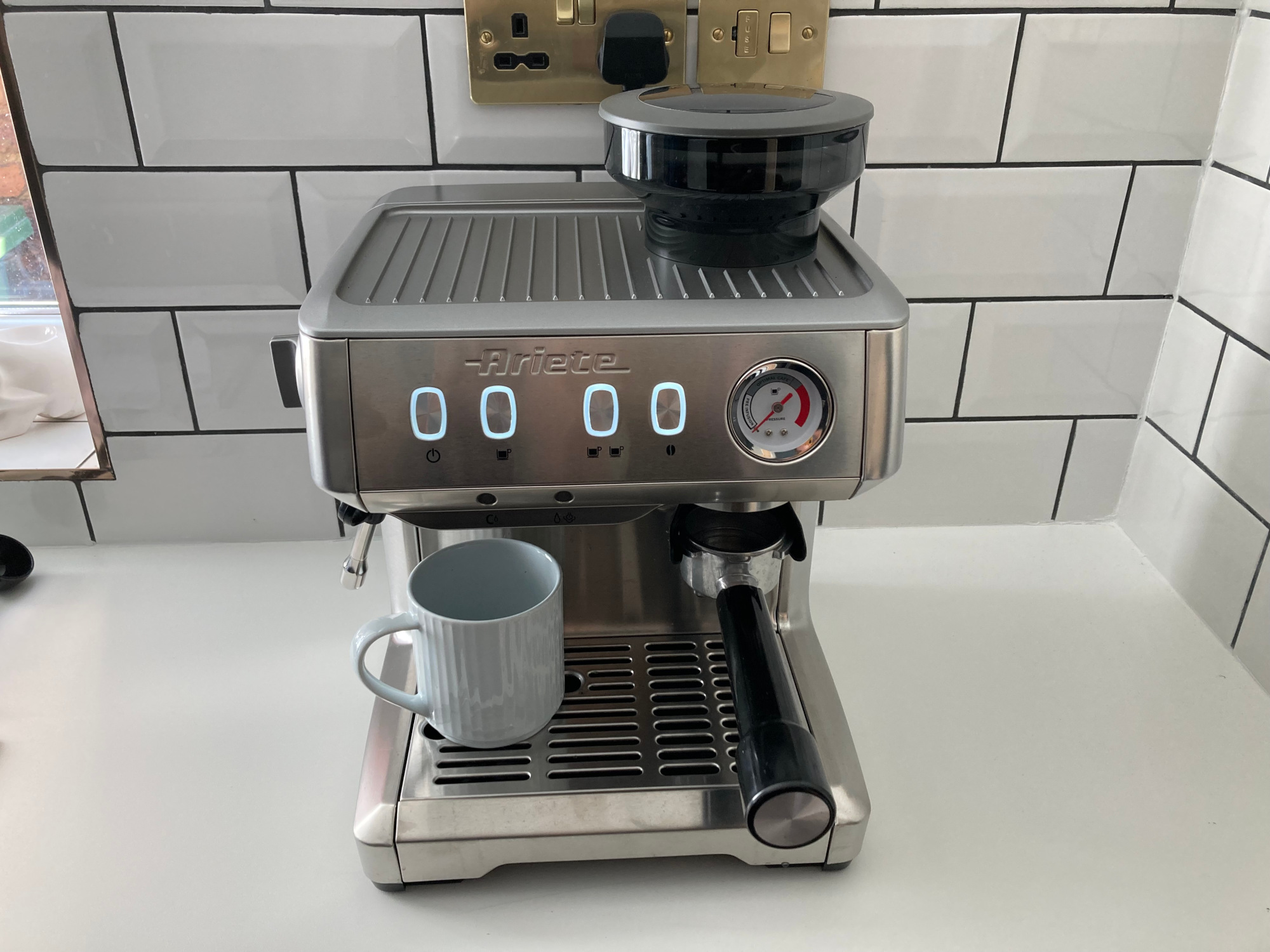
When I was introduced to the Ariete 1313 Espresso Maker, I was told this little-known brand (or little known in the UK) is the Vespa of the appliance world. Cute, reliable, and affordable, you aren't going to be doing the coffee equivalent of the MotoGP on this model, but you will get to learn the workings of a good coffee maker and what is needed to infuse the perfect espresso. And it doesn't look half bad on any kitchen counter.
At a glance, it is a lot cheaper than some of the best coffee machines of this type we have tested, so I was understandably a little suspicious about how it would compare. And this is no plug-and-go single serve machine either. A range of integrated features such as a built-in grinder and steam wand, plus something to show whether the pressure is optimal for creating great espresso, take this beyond the basic at-home single-serve or push-button coffee makers – this machine needs you to embrace your inner barista.
So, I set up the Ariete 1313 Espresso Maker in my other half's new kitchen (where it looked rather classy on the new white worktops) and went behind my beloved De'Longhi Scultura's back to test it on the side.
Ariete 1313 Espresso Machine: specs
- Water tank capacity: 2 liter
- Dimensions: L28 x W30.5 x H39.5cm
- Weight: 7.63kg
- Cord length:
- Power: 1600W
- Pressure: 15 bar
- Materials: stainless steel and some plastic
- Warming plate: Yes
- Programmable: No
- Key features: integrated grinder, steam wand, jug and portafilter included
Unboxing and set-up
The Ariete arrived in a cardboard box with a mix of cardboard inserts and a few plastic bags for protection. It was pretty self explanatory what everything was for, but there is a page at the front of the instructions that labels all of the pieces including the different portafilter attachments. You get a one cup, two cup and an ESE pod filter with this machine. Alongside all this, there is a built-in grinder (a nice extra on a machine of this price point), a coffee tamper/spoon, and a jug.
The machine arrives fully assembled, so you just have to give it a quick clean with a tank full of water before you get brewing. The water tank can be filled using a jug or disconnected and filled but we found it easiest to fill once in situ.
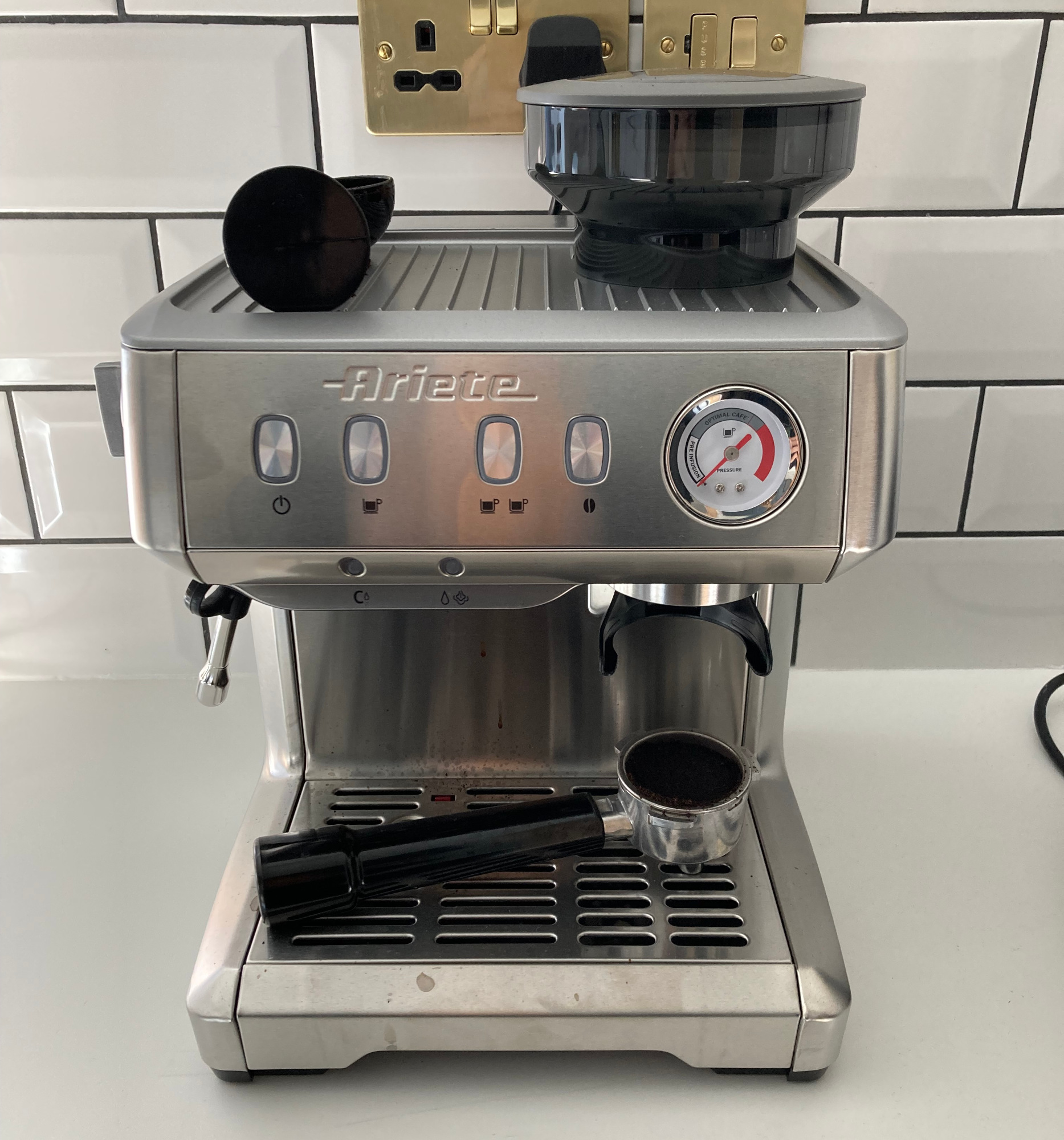
It was now time to get started. The instructions are not great. You get two rather chunky manuals with it and this is because they are written in several languages. The English section was only about 10 pages, so not overwhelming, and there are diagrams to help, but the ordering felt odd and we did find some bits ambiguous so ended up referring to videos on YouTube.
Fortunately these are very helpful so we followed one to see that we needed to switch the machine on (the on button will blink), then wait for all of the lights to light steady to know it is ready. With a bowl positioned under the filter and the steam wand also directed into the bowl, you just press the two cup button to rinse through.
Next, you need to do the same for the wand and water dispenser. Turn clockwise to the water drop symbol and dispense until the water tank is empty. You are ready to go!
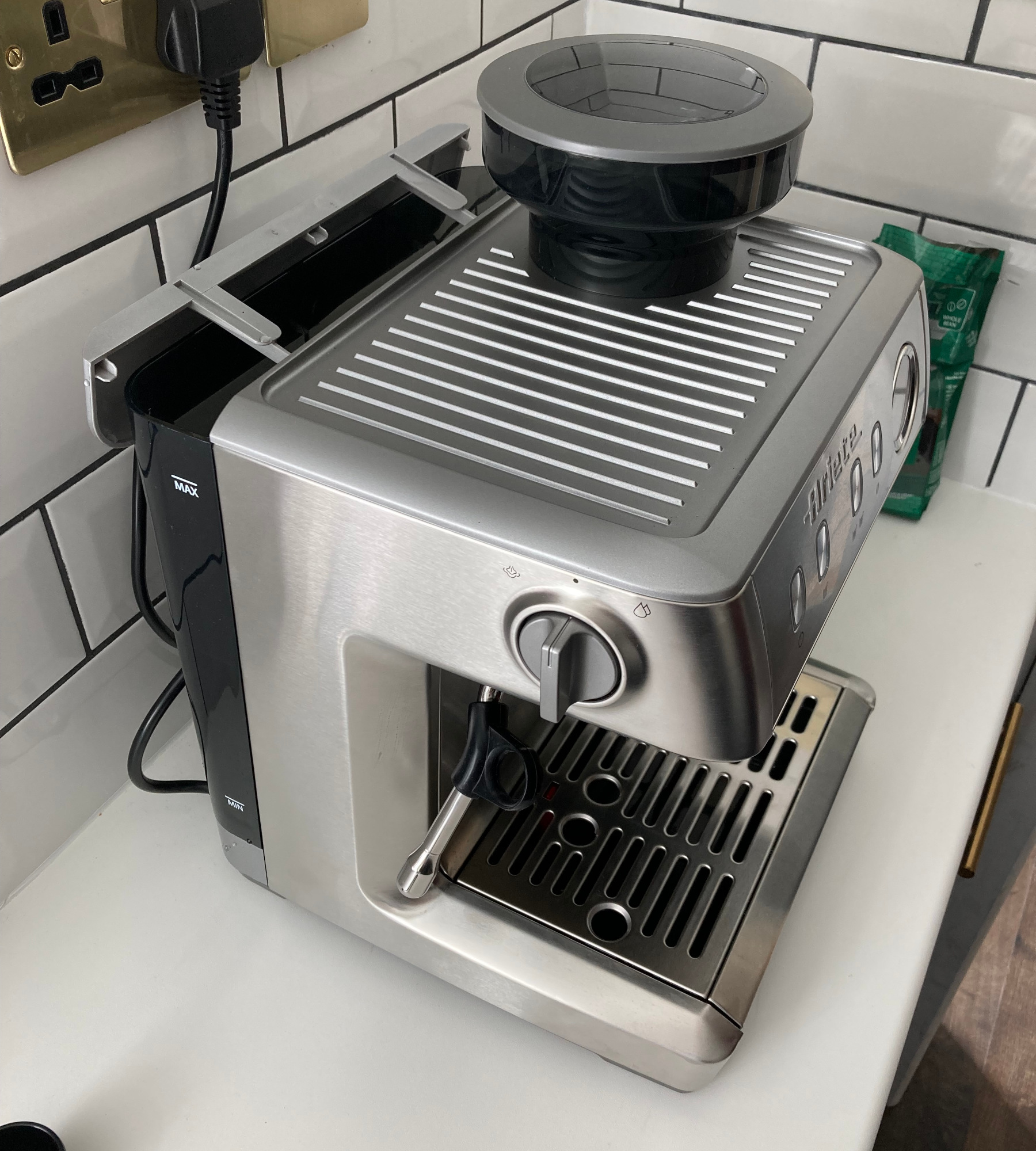
Making coffee with the Ariete 1313 Espresso Machine
We decided to start by making a straightforward espresso with some ready-ground coffee. The machine has just four buttons – on, one cup, two cup and grind – as well as settings for the steam wand/water dispenser and grinding level. So, we expected it to be fairly simple to use.
However, this is where I want to caveat that everything you are about to read is from someone who has not used this type of machine before. I consider myself an at-home coffee novice, having graduated from the school of pod machines, to using a fairly intuitive coffee maker that requires some measuring and tamping, but no further involvement beyond pressing the button to dispense water, or activate the steam wand.
When I read the instructions and saw stuff about the manometer (definitely not for measuring what I assumed) and pre-infusions, I considered ordering a Starbucks on Uber Eats. I was going to need caffiene and focus to get my head around this. But I perservered and read on, knowing if I got this right, the rewards would be barista style brews.
Eventually.
To make great coffee, you have to get four things right (aside from choosing the best beans of course). Firstly, your ground coffee needs to be the right level of courseness. Then you have to get the right amount in the filter. Next, you must tamp it down just enough – over pressed and you risk a bitter cup, under pressed and it may not extract under enough pressure to get a strong enough taste. And finally, you need to press the cup button for the right length of time to distribute the right amount of hot water for your drink.
If this already sounds like too many variables and you are not interested in learning, stop here, because this is not the machine for you. Coffee geeks, read on.

The manometer told me I had got everything right for this double espresso
Making espresso
I followed the instructions and heated the machine by running one cup through without any coffee in the filter. Next I filled the portafilter for one, and fitted to the machine. I was a bit confused about pressing the button for water. There are one cup and two cup options but you have to press for a certain length of time to get the required amount of water. The instruction manual was not completely clear but it does have a handy table showing water distribution times and here it says you need 13–18 seconds for one cup. As I wasn't sure, I pressed the one cup button for about 13 seconds.
Now, whether it was a case of my inability to count to 13, not measuring the right amount of coffee, or badly pressed coffee, I am not sure. But the first cup was watery and lacklustre. (Knowing what I have learnt since, the ground coffee I bought was also too course and probably not properly compacted).
I read the instructions again and realised that my best chance of making the perfect cup was by grinding my own beans for a slightly finer powder and starting again.
So that I can cover grinding in more detail, let's fast forward about 10 minutes and on a second attempt and I was gifted with a much smoother and more rounded cup of espresso. This time, I paid attention to the manometer and by skill or fluke I had managed to get the tamping, amount of coffee and water button time pressing just right, as shown by the gauge sitting in the 'optimal cafe' region.
I don't usually drink neat espresso, but the rich and slightly sweet short was very pleasant with a satisfying crema.
You can also use ESE pods in this machine but I have not tried that. I would recommend making the most of the built-in grinder and always using freshly ground beans to get the best results.
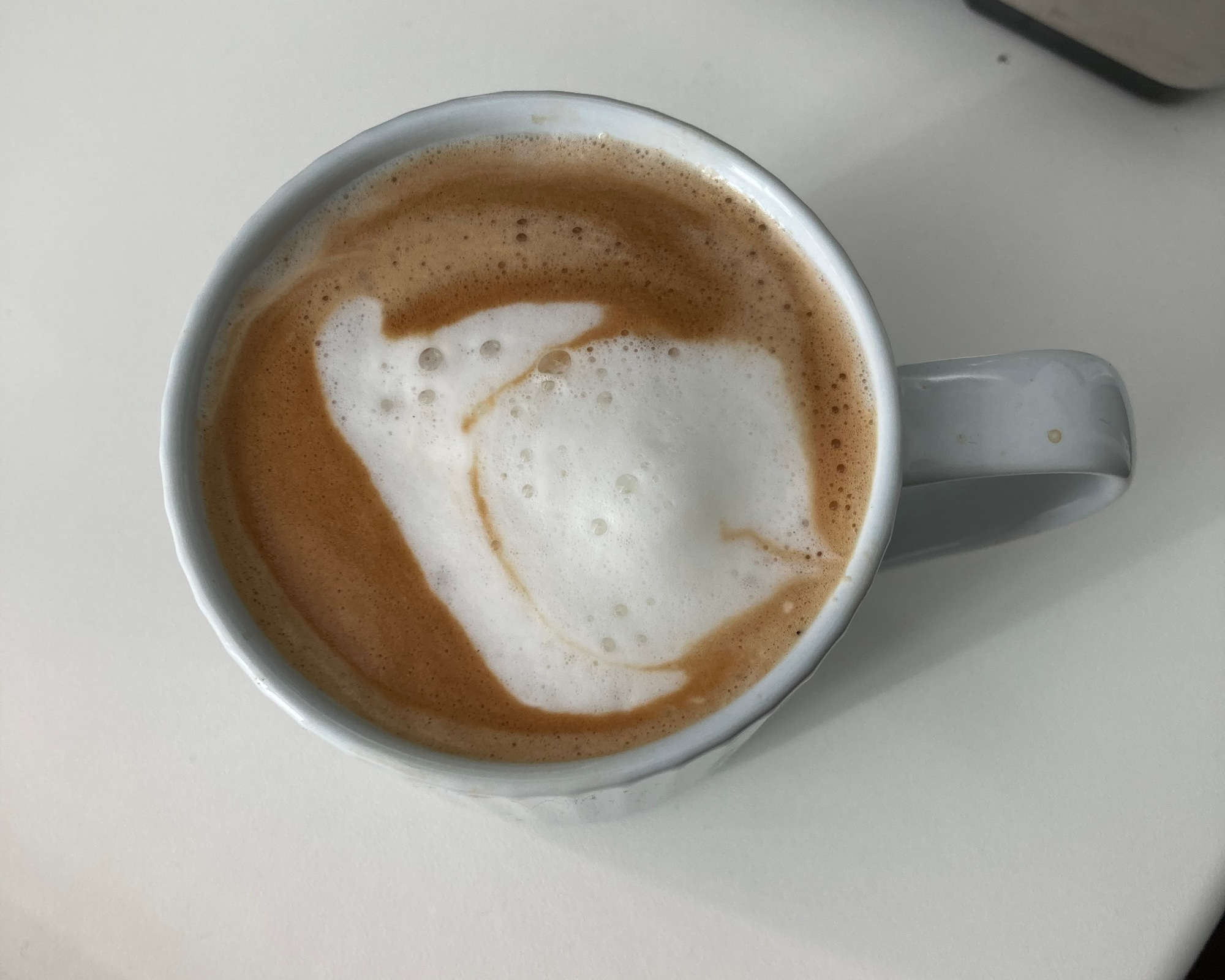
Making latte and cappuccino
Full disclosure, I am still not entirely sure at what point a latte becomes a cappuccino and vice versa, but I know a latte has more hot milk and less foam, and the cappuccino the other way round. Either way, it was time to make a milky coffee of some description. Which one would depend on how adept I was at using the steam wand.
The machine comes with a milk jug for this very purpose, which is a nice extra you expect on premium brands and saves a bit of money and time buying your own.
I made another espresso – a double this time – and steamed some milk using the wand on the side. I am no pro, but have this functionality on my current De'Longhi Scultura so get the basics. It delivered a silky hot milk that elevated my coffee to a nice long drink. I used oat, but have also used cow's milk for my other half on subsquent coffees.
While I might need to work on my latte art, the Ariete 1313 makes light work of everything from a flat white to a macchiato.
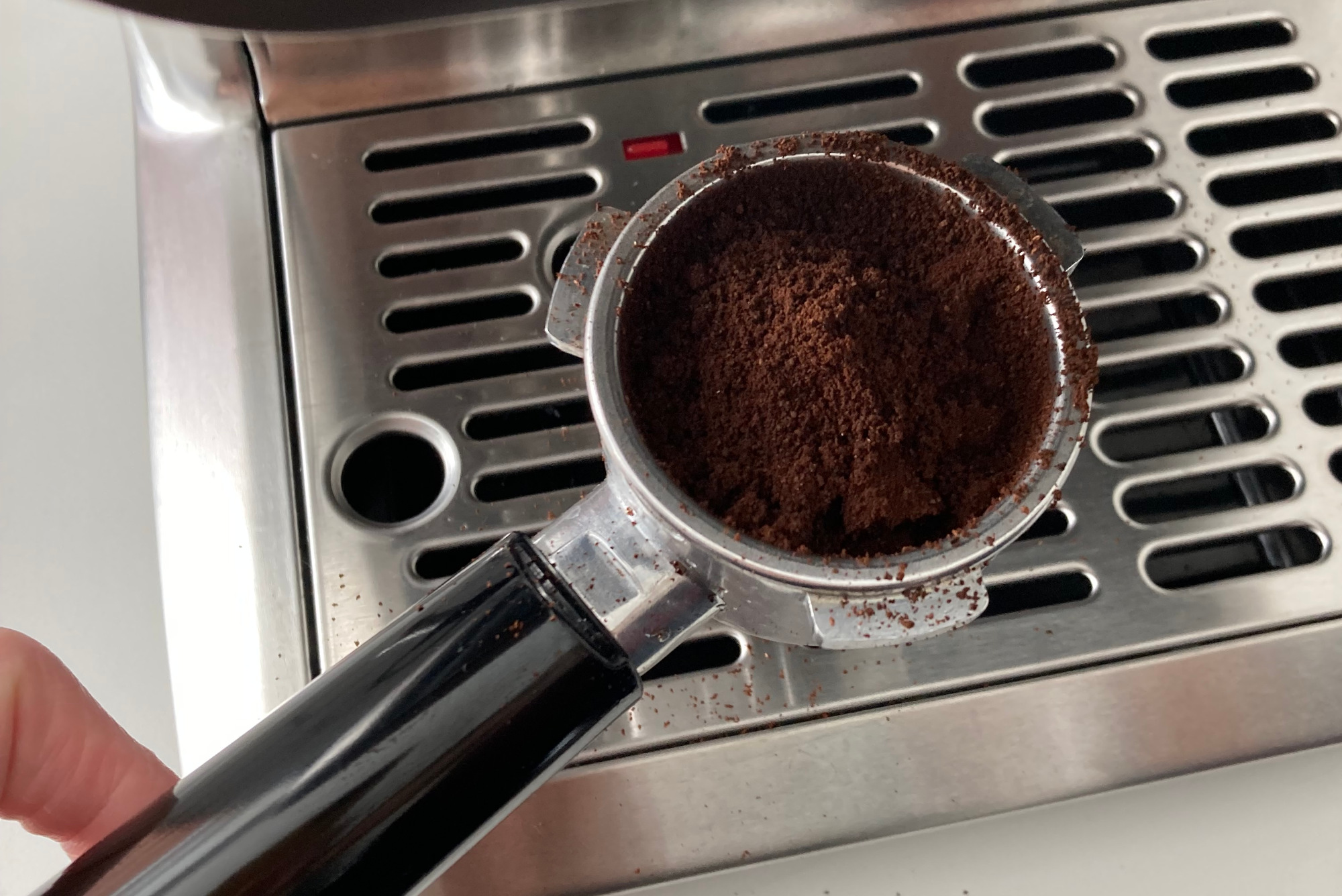
The grinder measures the required amount for one or two cups, albeit it messily
Using the Ariete 1313 steam wand and water dispenser
The integrated steam wand will not be hard to navigate for those who have used one before. The operation is not similar to that on my existing machine, which involves a priming button and dial, but is like those on many espresso machines. With a simple dial to turn anti-clockwise to activate, it is in fact less complicated than the one on my more basic machine.
This does mean you have a set pressure automated by the machine, so being adept with your jug and milk miniscus (probably not the technical barista term) is important. The steam light on the front of the machine flashes when steam is coming out.
Those who want to know how to make a cappuccino like a pro can spend far more time honing their milk steaming and frothing technique, but in my case, I just want some hot frothy milk to take the edge of my espresso. No problems here on that front.
You can also use the steam wand as a hot water dispenser by turning it clockwise. I did make a cup of tea using this to see how it was, and it delivered the water fairly quickly. I probably won't trade in my kettle, but if you only have counter space for one and don't drink much tea, it is a viable alternative. You can also use this to warm mugs, though the warming plate above does a fair job of that, too.
Using the built-in grinder
I have used dedicated electric coffee grinders and bean-to-cups where the process is all automated within, but never one where you grind straight into the filter.
This is great for those wanting maximum control over their beverage as you can set the grind level, from a choice of eleven settings. The instructions advise you start with eight and work down to five. Anything below five will likely be too strong and bitter for the average espresso fan, but the option is there. They also advise you avoid using the settings below five or above ten too often as they will make the machine wear out faster, either by overworking the grinder, or demanding too much pressure for infusions.
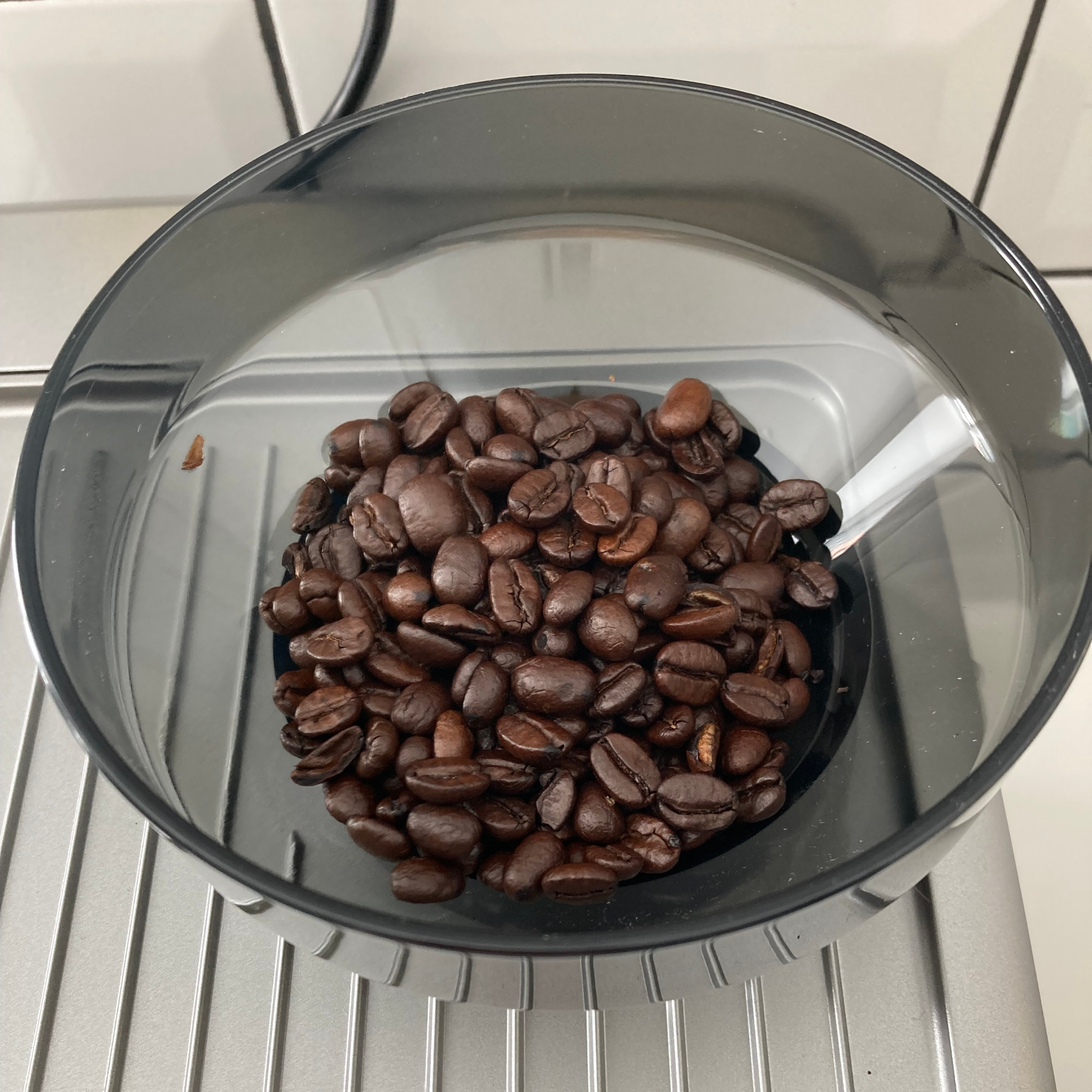
You simply fill the hopper with your chosen beans, clip the portafilter into place below the grinder (using the right filter for one or two cups), set the dial to your desired 'courseness' and it is ready. To get the right amount of coffee you simply press once for one cup, twice in succession for two, or hold it down for longer if you know you need a little more.
This is where the baristas among you can get a bit more technical and customise your grind level and amount to tweak the taste of your drink. For me though, having a pre-determined amount by pressing one cup or two is perfect and takes away the guesswork. The insturctions advised starting at eight and working down the grind levels as desired and we now use it on seven.
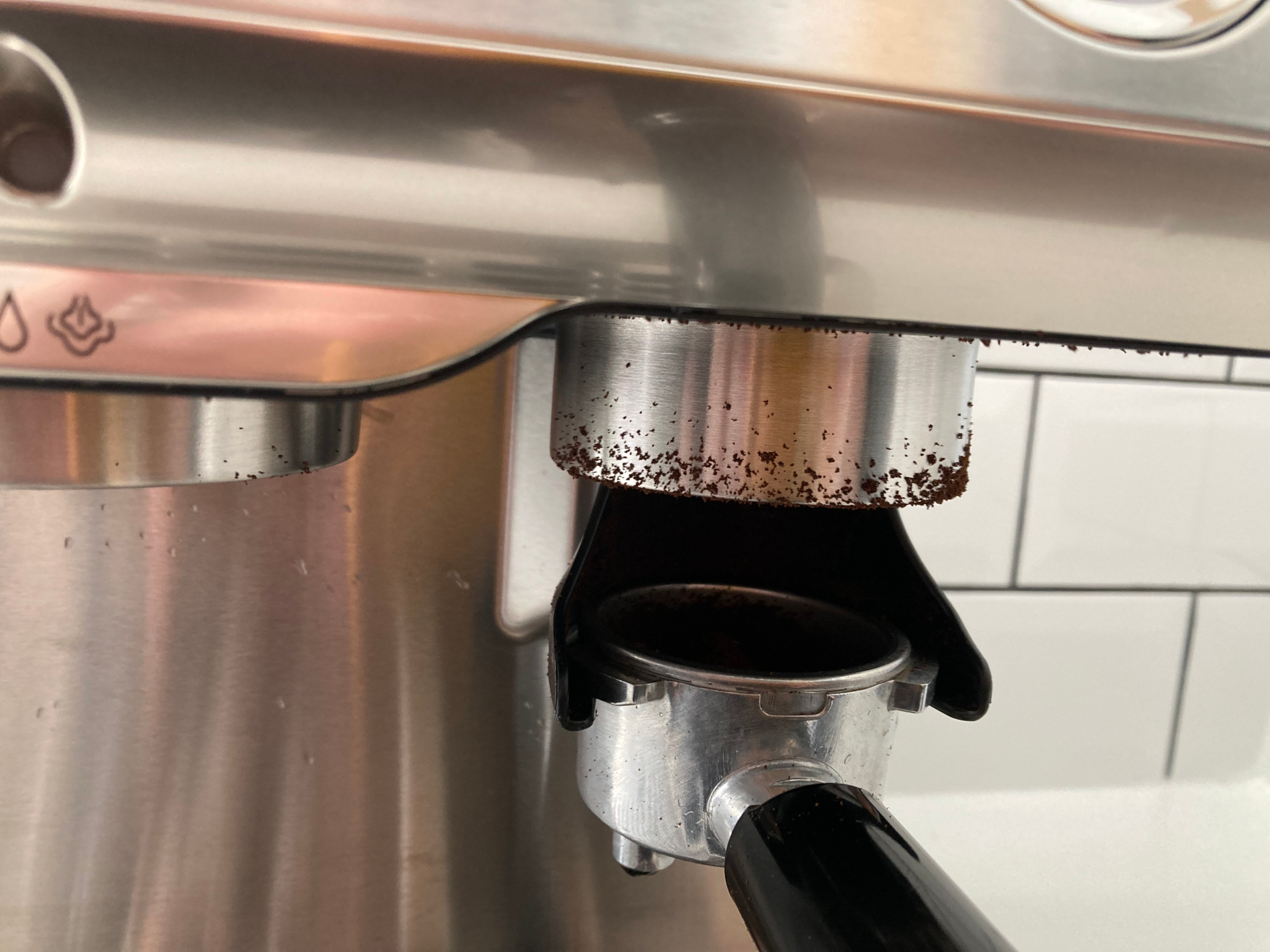
The portafilter clips into a plastic holder under the grinder
My only complaint about the grinder is that in its enthusiasm, it is a little messy. There is a sizeable gap between the grinder and the portafilter when fitted. This is no doubt to allow for the pre-compressed coffee of a two-cup grind.
However, it does tend to escape the area, covering the underside of the grinder, the surrounding parts of the coffee machine, and in our case, the white worktop. It is no major issue and certainly not enough to put you off buying, but it is best to clean the machine off before placing your cups in the mess. You don't want the vibration of the machine showering your fresh coffee with grounds.
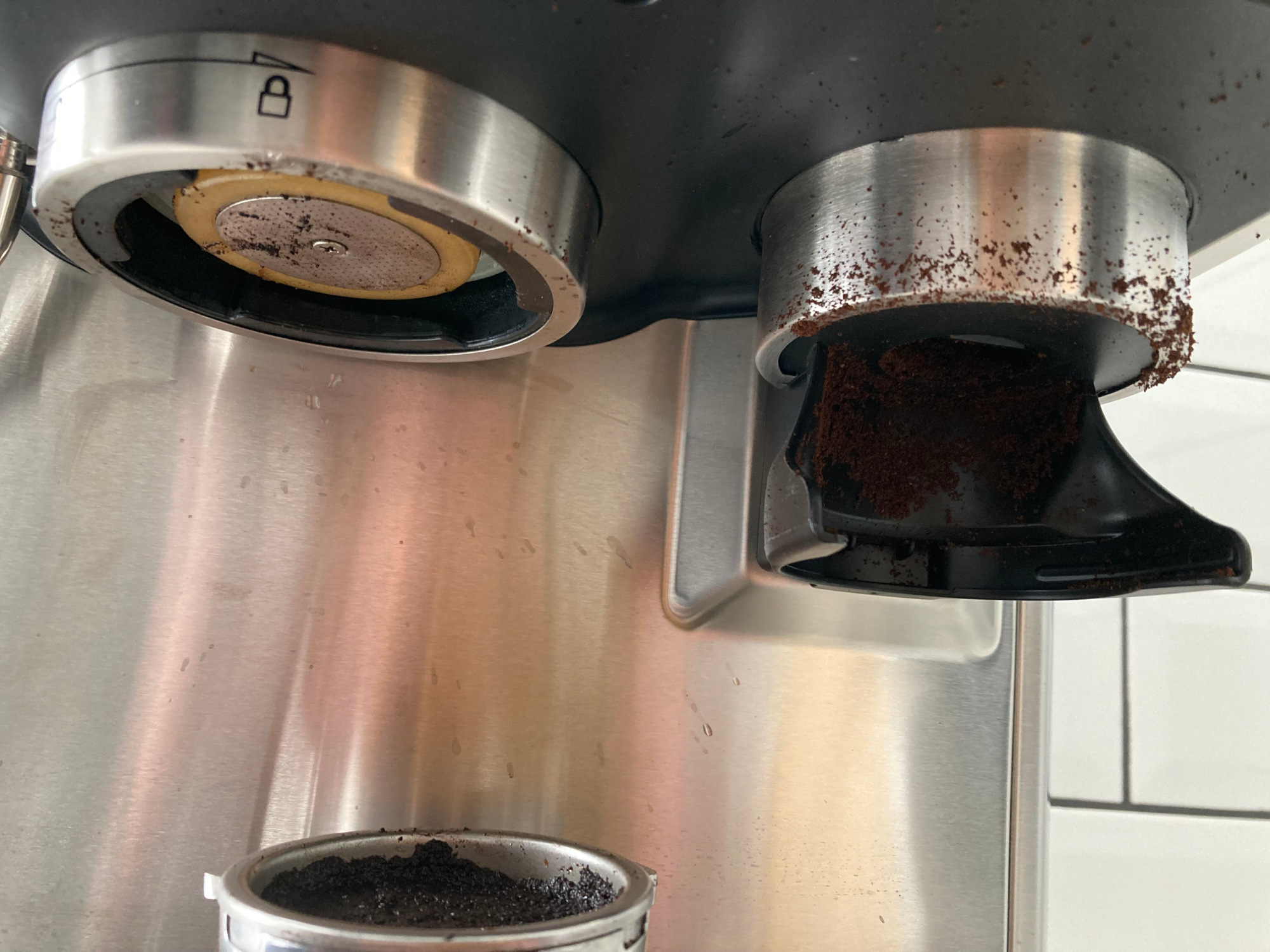
You may need a quick wipe round before the next step after grinding your coffee
How easy is the Ariete 1313 to clean?
Cleaning the Ariete 1313 is super easy. If you don't use the machine for a few days, you need to run a tank of water through the filter and water dispenser as you do before the very first use. Everything else just needs a wipe down from time to time and the removable parts can be washed in warm soapy water. The jug is dishwasher friendly as is the spoon and tamper, but the rest should really be hand washed.
To clean the steam pipe, you can remove the external tubing and hand wash, using a small bottle brush for anything stubborn. Letting steam and/or hot water run through after each use will also keep it clean and milk free.
If the machine needs descaling, all of the lights on it will turn red. This hasn't happened to us yet, but from watching videos, descaling looks similar to the standard clean, but you add a descaling agent to the tank first. Then follow up with a rinse through of clean water. If you know how to clean a coffee machine already, the process will be familiar.
How does it compare to similar models?
I haven't used other espresso machines with integrated grinders so asked our coffee expert Millie Fender how it compared spec-wise to the market leaders. There are lots of products out there that are virtually the same, but some have added dials to allow greater adjustment, while others go down a techy route with touch screens and automated programmes.
Here we are considering a couple of machines we have had our hands on which fundamentally do the same thing.
A similar model for functionality is the Breville Barista Max which comes in at over £400. The design and features are very similar, but you get a 2.8L water tank, 30 grinder settings and programmable hot water temperature. It doesn't have a pressure gauge, but it takes a bit of the guess work away and allows you to change the water temperature should you desire. So it both gives you more control and less room for error, depending on how confident you are in making espressos. We gave it 4.5 stars, and liked how easy it was to use despite being comparable to commercial machines in terms of features.
For over twice the price of the Ariete you can get the Sage Barista Express which is for those who are more serious about making top quality espresso at home. As well as some nice accessories thrown in like a temperature indicator on the milk jug and a razor dose trimming too to perfectly tamp your grounds, it also has settings you can adjust and preset to programme in your perfect espresso. There is digital temperature control but brew temperature can also be adjusted. The pre-infusion can be changed too. The tamper is built in which is a small thing but keeps it neat. This machine is consistantly applauded for making great coffee and leaving little to be desired in the way of added features, so without having tried for myself, it again comes down to whether you are willing to spend much more for that little bit more predicability. There is also the prestige of the Sage brand that adds to the price. We also gave it 4.5 stars.
Should you buy the Ariete 1313 Espresso Machine?
I would definitely recommend this machine to those who are really looking to up their at-home espresso game, but don't have the budget for the very well known products in the bean-to-cup market from Sage, Breville and De'Longhi. As it happens, the brand is now owned by the same company as De'Longhi and you can feel that same Italian coffee heritage in its design.
It offers plenty of scope for customising your drink and really learning about the infusion process, but has a safe space for people like me in the preset options for grind amount and water distribution. If you are just getting into making your own coffee a little more seriously, you won't be disappointed – nor are you taking the risk of spending over £500 to find you really can't be bothered.
For not much more than my current machine (the De'Longhi Scultura) that has no integrated grinder and doesn't get on with finer grounds, I would be happy to swap to this machine – even if each cup does take a bit longer.
Overall I rate this machine 4 stars. Some finessing of a couple of funtions and the instructions would be helpful, but shouldn't disuade you from giving the Vespa of coffee machines a go.
About this review and our reviewer
Lindsey Davis is Editor in Chief of Real Homes and Editor in Chief of Ecommerce for Future. So, as well as being a savvy shopper with a penchant for DIY, she also knows a few things about product testing too.
She was sent the Ariete 1313 Espresso Machine to test and set it up in her partner's home. This meant she could use it regularly while comparing to her own at-home coffee set up: a De'Longhi Scultura and French press combo (with the odd instant when she is too tired to wait). Her favourite coffee is an oat milk latte, but since getting to grips with this machine, she is leaning into less milk-laden brews. It is unlikely you will ever see her necking a ristretto though...
Ariete have allowed Lindsey to keep the machine, so while she has been using it for some months already, she will be able to update her review to explain how it endures the test of time.
Find out more about our testing process on Real Homes.
Join our newsletter
Get small space home decor ideas, celeb inspiration, DIY tips and more, straight to your inbox!

Lindsey is Editor of Realhomes.com and Editor in Chief for Home Ecommerce at Future. She is here to give you aspirational, yet attainable ideas for your home and works with her team to help you get the best buys, too. She has written about homes and interiors for the best part of a decade for brands including Homes & Gardens, Ideal Home and Gardeningetc and isn't afraid to take the inspiration she finds at work into her own space – a Victorian terrace which she has been (slowly) remodelling for the last eight years. She is happiest sipping a cup of tea with a cat on her lap (if only she had a cat).
-
 Jennifer Garner's dining room is filled with “cohesive and intentional” features that showcase her personality
Jennifer Garner's dining room is filled with “cohesive and intentional” features that showcase her personalityDesigners love how the actor's space is rustic yet refined
By Eve Smallman Published
-
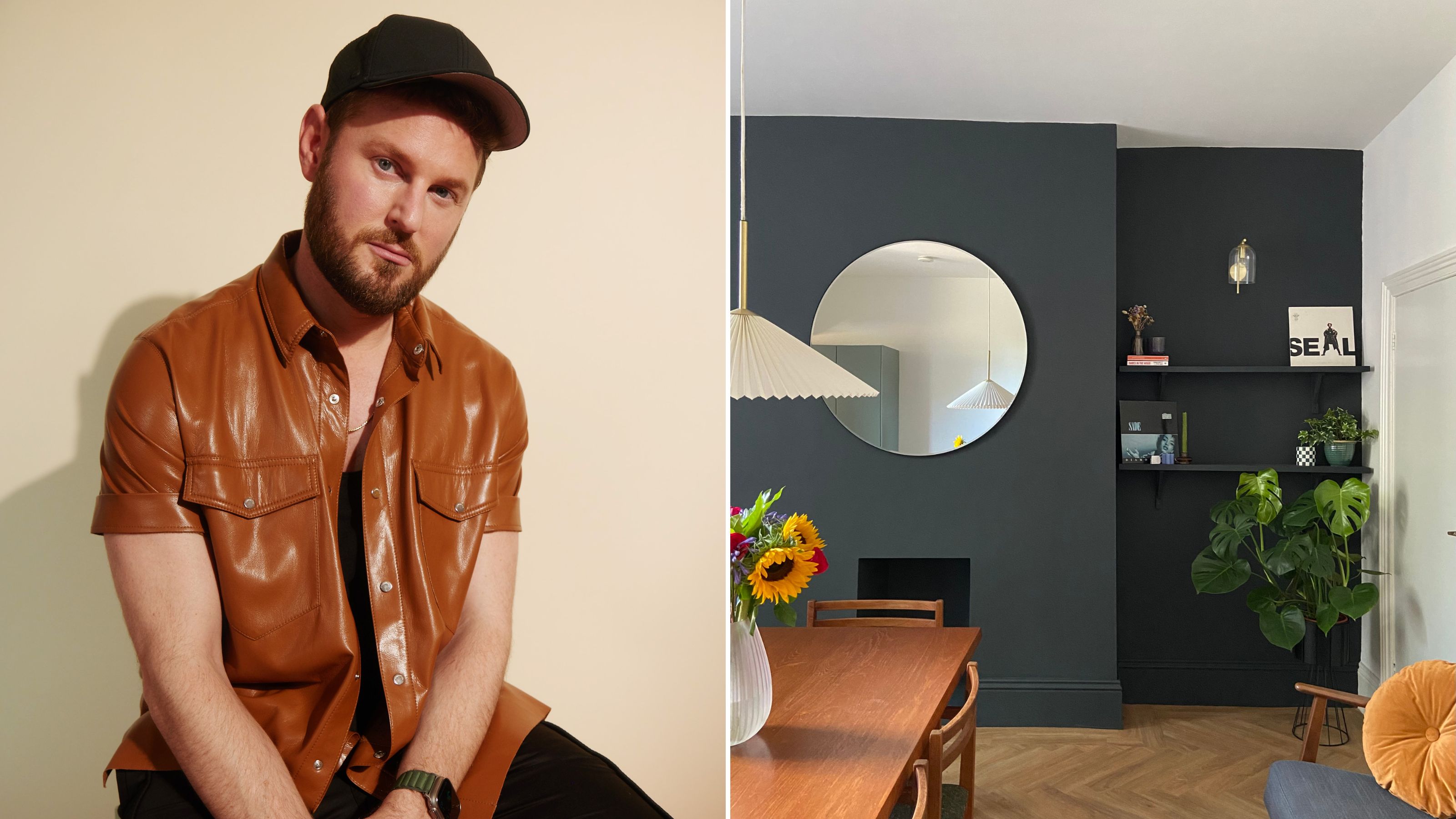 Bobby Berk has revealed his favorite wall paint color — designers agree that it's a chic choice
Bobby Berk has revealed his favorite wall paint color — designers agree that it's a chic choiceThe Queer Eye star's choice of black is elegant and easy to decorate with
By Eve Smallman Published
-
 Vanessa Hudgens’ wallpaper puts a trendy twist on a classic style — designers love her effortless approach
Vanessa Hudgens’ wallpaper puts a trendy twist on a classic style — designers love her effortless approachThe actor's nature-inspired print is characterful and chic
By Eve Smallman Published
